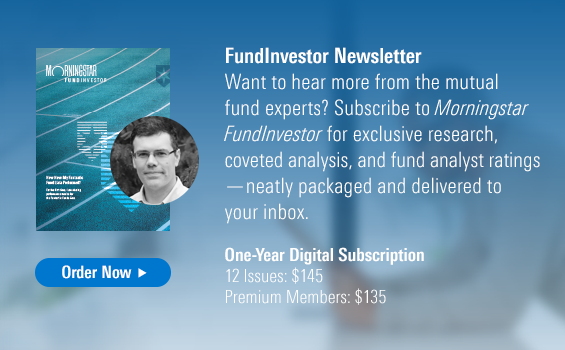From Good to Gold
Here's a look at how several funds recently earned the top Morningstar Analyst Rating.
How does a fund earn a Morningstar Analyst Rating of Gold? It isn't easy. The fund has to rate highly on nearly all five Pillars: People, Process, Price, Parent, and Performance. The road to earning a Gold rating usually lacks the obvious trigger of funds that we downgrade. Manager changes rarely lead to upgrades.
But that doesn't mean things aren't going on under the surface. You want your doctors, pilots, and dentists to be experienced, yet you probably can't point to the exact date when that happens. In our case, it's often a matter of seeing a manager through more environments. It's not just about performance; it's also about if these funds live up to their stated strategies. Some of this you can judge right away, but other aspects take some time.
Likewise we also look at the supporting analysts for sufficient experience, skill, and stability. A firm may have a wave of departures of managers or analysts, and it takes some time to be assured that things have changed.
All this is a way of saying that subtle but real changes can get us to a Gold rating. Let's look at several funds that recently made the grade.
It's been a long uphill climb for
That stability is a great sign of buy-in from key personnel, but we also watched closely to see how things would work with the three comanagers running the fund. PIMCO named Scott Mather as lead with support from comanagers Mihir Worah and Mark Kiesel. In addition, Dan Ivascyn was named chief investment officer and thus was another important voice in the fund's direction.
It's not easy to build a functional and cohesive team, so we wanted to wait and see how things worked out. Over the course of many conversations and visits, we've seen that the team has come to work well together, and that has been borne out in results. We raised the fund to Silver a year ago and now to Gold as we see it's on a par with the best in the intermediate-bond category.
It's still a rather wide-ranging fund that makes an array of macro and micro calls using securities and derivatives. Performance has been solid, but it's really that cohesion of people and strategy that led us to elevate the fund to Gold.
But it wasn't just returns that got us to Gold. More important was that the firm retooled its strategy in the hopes of moderating returns a bit while at the same time staying true to its emphasis on making money with credit. We've been pleased as Western Asset executed the strategy of still producing solid returns with a closer focus on risk. Senior analyst Maciej Kowara describes a team and strategy that have come together nicely:
Western Asset is one of the premier fixed-income shops in the industry and can command research resources that are commensurate with this status. Of a grand total of 126 investment professionals, 28 are devoted to broad market strategies, another 28 to emerging markets, 17 to high-yield, 21 to investment-grade credit, and 11 to structured products, among others. These numbers make it one of the better-staffed asset managers among its competitors.
This large and diverse team is tasked with contributing to developing Western's investment outlook and executing it within the investment constraints of its various offerings. Senior members of the investment team, under the leadership of CIO Ken Leech, form a U.S. broad strategy committee that sets the firm's positioning on rates, yield curve, and sectors, among others. These forecasts have more often than not hit the mark. Once these themes are set, portfolio managers implement them. This part of the process has two aspects. Sector heads and individual analysts help managers with security selection, and the latter affect portfolio construction with the use of Western's risk system, which took multiple years to complete after its 2010 beginning. That system is notably important here given its utility in helping this fund's managers in their aim to diversify sources of risk.
Besides the gradual improvement at the fund, we also noted improvement at parent company Legg Mason, leading us to upgrade the Parent rating to Positive. Together, these developments led us to raise the fund to Gold in December.
Having a diverse portfolio of 300 names is common for quant funds, as the idea is to emphasize measures that have worked over time without being overly dependent on a handful of stocks. This fund's fundamental and fairly transparent drivers boost its appeal over many quant funds that are black boxes and can be frustrating to those trying to figure out the right way to use them. In addition, the fund's 0.81% expense ratio means it doesn't have far to go to catch up with small-cap index funds.
Sometimes the road to Gold isn't all that complicated. Schwab cut the expense ratio at
The JPMorgan SmartRetirement funds had a few drivers that brought us to Gold in February 2018. One was a fee cut. Target-date funds often have a fund-of-funds structure, so you need to pay attention to the summed-up prospectus expense ratio in order to compare funds. In this case, cuts in the fees of underlying funds gave the target-date funds fees between 0.41% and 0.51% for R6 shares. Equity-heavy later-dated funds like
The second piece of the story was continued strong execution from a stable team led by Anne Lester. It's a very experienced team that also includes key managers Dan Oldroyd, Mike Schoenhaut, Eric Bernbaum, and Jeff Geller, and it has led the funds to top-quartile performance over the trailing five- and 10-year teams. (Performance varies by target-date year and share class.)
The third piece was that we upgraded the two biggest underlying funds in the target-date series. We raised


/s3.amazonaws.com/arc-authors/morningstar/fcc1768d-a037-447d-8b7d-b44a20e0fcf2.jpg)
/cloudfront-us-east-1.images.arcpublishing.com/morningstar/HDPMMDGUA5CUHI254MRUHYEFWU.png)
/cloudfront-us-east-1.images.arcpublishing.com/morningstar/OMVK3XQEVFDRHGPHSQPIBDENQE.jpg)
:quality(80)/s3.amazonaws.com/arc-authors/morningstar/fcc1768d-a037-447d-8b7d-b44a20e0fcf2.jpg)